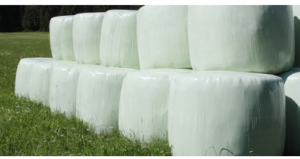Silage wrap keeps bales of forage airtight as they ferment, preserving the natural nutrients livestock need during winter. However, it’s essential to understand how different types differ in strength and barrier properties.
Coveris Northern Ireland launched clear Unterland Crystal quality six years ago and says it is now popular with farmers nationwide. It offers several benefits compared to black wrap. For quality silage wrap, check out silage wrap for forage now.
Cost
 It’s important to remember that forage producers spend a lot of time and money on the crops they produce. That is why it’s disappointing when those hard-earned crops are lost due to insufficient protection. That’s where silage wrap for forage comes in.
It’s important to remember that forage producers spend a lot of time and money on the crops they produce. That is why it’s disappointing when those hard-earned crops are lost due to insufficient protection. That’s where silage wrap for forage comes in.
Silage wrap aims to keep the moisture content in the optimum range and promote controlled anaerobic fermentation to raise nutrients and enhance tastefulness for animals. It also protects the forage from mould, rot, and heat loss, as well as improves the efficiency of storage.
Producers have long recognised that a delay between cutting and wrapping is detrimental to forage quality and yield. A delay in wrapping results in heat accumulation, plant respiration, and fungus growth that produces water-soluble sugars, which cause wet forage to spoil. In addition, rain and lightning can wash away the crop and damage equipment. It can significantly affect the cost of buying and selling standing forage.
Fermentation
Fermentation is crucial to preserving forage nutrient content, but it cannot be easy without high-quality silage wrap. The film creates an anaerobic environment inside the bale, allowing lactic acid bacteria to do their work. It reduces dry matter losses and increases energy content.
Bales are wrapped in four to six black, white or green 25-micrometre plastic layers. The wrapping machine applies the film over the bales as they are pushed through.
Wrapping the forage before it wilts allows moisture to be reduced, which can help reduce spoilage and improve feed value. It also helps to reduce the presence of moulds that produce mycotoxins.
A good silage wrap should be UV stabilised to avoid degradation and maintain its tear resistance during handling, stacking and storage. A low-tear film is best for small and large round bales, but it’s also possible to use high-performance mLLDPE films on smaller, square or haylage bales. These wraps have higher strength and stretchability, making them more resistant to punctures from rodents.
Weed Control
Silage wrap keeps weeds out of hay and straw bales so that they can be used for feed. It also helps preserve the nutrients and nutritional value of the crop. It means that animals will get a higher quality food source, which can lead to better health and performance.
A high-quality plastic film for silage wrapping can help improve the quality of the resulting feed. A good silage wrap should be strong, durable, and weather-resistant. It should also have a high tear resistance and UV protection to reduce degradation over time. For quality silage wrap, check out silage wrap for forage now.
Holes in the plastic that allow forage to enter the bales and spoil can be a significant problem. Deer, hogs, groundhogs, and raccoons can all cause holes in the plastic that allow moisture to enter and lead to moulding and rotting of the forage. Bales should be stored where these problems are less likely to occur.
Storage
Silage wrap can help keep hay and straw bales airtight, allowing them to ferment and preserve their natural nutrients for livestock when needed. It can also reduce weed growth and prevent damage to the bales. It’s essential to use high-quality silage wrap that’s easy to apply and stick together for a tight seal. Poor silage wrap can compromise the anaerobic conditions, leading to spoilage and reducing feed quality and animal health.
Another consideration is the timing of wrapping. Bales wrapped too soon can heat up because of plant respiration and fungus growth. This heat can cause the pH to drop and ensile the forage.
A study of alfalfa silage showed that bales wrapped within 4 hours of harvest had higher total digestible nutrients (protein, lipid, and carbohydrate) than those covered at 8 hours or later. Higher digestibility means more nutrients for the livestock to absorb and use, which can lead to greater milk output.
Comments are closed, but trackbacks and pingbacks are open.